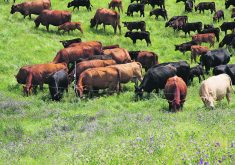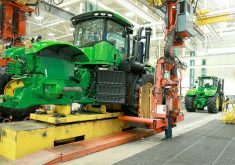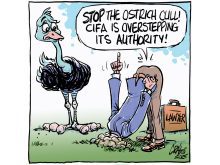Target criticism
Re: page 54, (Aug. 16 issue) Fire? Target? Only in Alberta, eh?
As a family paper – and one dedicated to help stamp out violence and equal rights.
As a grandparent, I resent that the picture of “the dude” – slang as well – of a female form being used for target practice as well as pointing out “a couple between the eyes.” At least (there was) no mention of the shots in the butt.
This abuse is not necessary. What happened to regular bull’s- eye targets? Gender friendly it’s not.
Read Also

Trump’s trade policies take their toll on Canadian producers
U.S. trade policy as dictated by president Donald Trump is hurting Canadian farmers in a multitude of ways.
– Herb Kreuger,
Stonewall, Man.
Growing poplars
The latest cabinet minister to venture back to Saskatchewan is advocating that farmers turn to growing trees. He had better give his head a shake.
With logic like that, no wonder the prime minister thinks all Western Canadians are stupid.
I assume the minister is talking about growing poplars, as it takes about 100 years to grow spruce. Even a marketable poplar would take about 30 years.
Supposing that you can find a lumber company that would be interested in poplar, how could you pay taxes on your land and live until then?
When I was young enough to tramp through snow up to my belly button, I felled spruce trees for the Carrot River sawmill. Incidentally, this was to subsidize my grain farm. Poplar trees were considered weeds to be smashed down with the skidders and cats and left to rot.
In our area, northeast Saskatchewan, it is possible to grow trees. I’m sure the fellas west of Kindersley will be interested.
The only trees out there were planted by some hardy pioneer who was determined to have a shelter belt around his yard and no doubt carried water to them with a pail.
The farmers I know are using their land to the best of its potential. Don’t insult their intelligence, sir. They are producing top quality food for us all.
Maybe spend a little more time developing an ag policy that would at least give them the cost of production back before we all wake up hungry. Poplar sticks don’t taste good.
– Don Dawson,
Nipawin, Sask.
Bill C-15
In her letter to the editor Aug. 23, Shelagh MacDonald, Canadian Federation of Humane Societies, claims her group is “working hard to educate the public, politicians and media about what Bill C-15 really means.”
If her letter is an indication of what they are saying in these education efforts, then the agriculture community truly has cause for concern.
Canada’s agriculture and food production sector is firmly on record as endorsing the stiffer penalties proposed in Bill C-15 to deal with repeat offenders or depraved animal cruelty imposed by anyone, including farmers.
To imply otherwise is inappropriate and totally misses the point of the sector’s concerns.
Those of us who would like to see the Criminal Code’s animal cruelty provisions modernized and strengthened should not allow such worthwhile objectives to be embodied in poorly drafted legislation.
Such is the case with Bill C-15. Ms. MacDonald argues that criminal charges are usually, but not always, laid by a crown prosecutor or humane society.
As such, she tries to sweep under the rug the very real risk of nuisance prosecutions that this new legislation would invite.
There are many animal rights groups who are on record as hoping this new legislation will be used to broaden prosecutions and to challenge necessary animal husbandry practices.
She would also have us put our faith in the judgment of the crown to protect legitimate animal owners from “frivolous” charges.
We would prefer to put our faith and our families’ livelihoods in clearly worded legislation rather than in the discretion of individuals who may not have any understanding of agriculture.
The Canadian Cattlemen’s Association believes that legitimate activities may be affected by the proposed changes to the Criminal Code….
Denigrating the concerns of the agricultural community appears to be an attempt to deflect attention away from legitimate legal concerns surrounding Bill C-15.
Groups such as CCA are simply seeking to keep the same legal up-front protections for legitimate animal owners under the new legislation that we currently receive and are entitled to today.
– Peggy Strankman,
Canadian Cattlemen’s
Association,
Calgary, Alta.
Thanks, CWB
It was interesting to read Barry Wilson’s comments in your (Aug. 9) edition re the proposed merger of Agricore and United Grain Growers.
There is no doubt that the new company will want the Canadian Wheat Board out of the way. I would add that as our grain producers continue to age and others are squeezed out, the support for the CWB will vanish at the producer level.
The present CWB grain “cartel” has served us very well as the new century emerges. We have seen the initial price for wheat increased three times in the last crop year and all the benefits continue to reach the primary producer.
Thank you to the CWB for continuing the fine job on our behalf. I cannot say the same for the oilseed industry where price setting is beyond my control.
– Lorne Radcliffe,
Cardale, Man.
No tag benefits
In a recent edition of The Western Producer (Aug. 9) there was a letter by Mr. (Brad) Wildeman in regards to the national identification on Canadian cattle.
Mr. Wildeman didn’t spend much time or space in pointing out the benefits of this program, which is understandable, as there aren’t any.
It’s not a case of what it does for the producers of cattle. It’s a case of what it does to them, and most producers of cattle that have anything to think with will agree with this.
As far as the health of our livestock is concerned, it would be absolutely worthless. If the outbreak of foot-and-mouth in Great Britain would have depended on some stupid tag system, like the Canadian Cattle Identification Agency is forcing onto Canadian producers, then they would have never been able to control any part of this foot-and-mouth outbreak, and neither would we in Canada, under any circumstances.
We don’t seem to have any sign of any prevention in this country of diseases coming in from other countries. Just read in the papers, where people coming in from other countries had to ask Canadian Customs to disinfect their footwear. …
Oh yes, Mr. Wildeman, you forgot to mention all the advantages to the original producer, or maybe you are like everyone else, you couldn’t think of any.
To start with, the original producer buys the tag. Then he is threatened and harassed by the CCIA if he doesn’t have 95 percent of his cattle tagged when they leave his premises. Fines of $500 to $2,000 are issued.
He is also liable for any sickness or damage to the critter that he had sold months before to a feedlot or backgrounder.
The original producer is still held responsible regardless of where this animal has been after it leaves his hands.
We at the ranch ship our calves directly off the cows in the fall. Now if we have to put tags on, between the time we take them away from the cow, and loaded on the liner to be hauled to the sale yard, it would mean handling these calves for about an hour or more to put the tags on.
We have good facilities to do the tagging. But to handle a liner load of calves to tag them would put at least one and one-half to two percent shrink extra on this load of calves, at the present time and price. This would cost at least about $12 a head on shrink.
To put the tags on at calving time, when the calves’ ears are thin and tender, would mean a lot of lost tags. Of course, your CCIA would benefit, as we would have to buy more tags to replace the lost ones. …
Between the tagging, shrink, and the Alberta Cattle Commission grabbing $2 per head on your cattle cheque, it makes one wonder how many more freeloaders the producer can stand.
– Ivor Clarke,
Valleyview, Alta.
No choice
With regard to the cattle ID program, in the Aug. 9 publication of The Western Producer, Brad Wildeman of the Canadian Cattle Identification Agency states, “But it looks like the majority of producers care about their industry and their livelihood and have decided they should support the program.”
Having personally attended many meetings dealing with the cattle ID program, I say it is no wonder that producers have decided to support the program. They have had no choice.
The scare tactics and heavy-handed attitude used on the producers by bureaucrats caused producers to comply.
The threat of “you will be unable to sell your cattle unless tagged” and the threat of fines which varied anywhere from $50 to $2,500 depending on the meeting one attended. …
Brad Wildeman also claims that people such as myself and Archie Shaver used “determined resistance and misinformation.”
Oddly enough most everything people like us predicted has come to pass. We were led to believe that all we would have to do was tag our cattle.
Then in the Aug. 23 publication of The Western Producer, under the headline “Ear tags now applauded” (I know of no one applauding the program except the bureaucrats): “Cattle producers soon will face a flurry of new bureaucracy and record keeping demands as food safety, environmental issues and product traceability become government or industry requirements,” CCA vet, Joyce Van Donkersgoed states. “More paperwork and consumer demands are coming” and further, “this is not a conspiracy against you.”
Many of us question the underlying motives.
Are these programs being imposed on us in order to drive the individual producer out of business in order to make way for the ILOs?…
As for the notion that the U.K. was able to control the foot-and-mouth disease due to tagging, I have friends in the U.K. who kept me informed from the front lines, so to speak, and without going into any of the sad details, I am well aware of the mess that the bureaucrats caused there.
Many producers will never again be in livestock production.
– G. Leona Green,
Dawson Creek, B.C.
Hemp crop
It is indeed enlightening to first of all read assurances that hemp has no psycho-active chemical content, yet the issue of hemp-as-a-crop in Canada is being closely if not religiously followed by those who would have the cannabis sativa plant, known as hemp and known as marijuana, decriminalized and eventually legalized.
The Dutch, of course, already have experience in this area. Their monitoring activities reveal that perhaps as much as 90 percent of hemp crops grown in Europe are sold in the marijuana market.
In the fields, high tetrahydrocannabinol (THC) plants cannot be distinguished from low THC plants. Only a laboratory analysis can differentiate between them.
The economics of the hemp crop lie in the THC-containing leaf and bud portions of the cannabis plant, not in the fibre of the stalks ostensibly to be used to produce hemp textiles.
– Ken Lane,
Canadian Communities Against Substance Abuse, Drug Watch International,
Victoria, B.C.
Praise for story
Re: Farming magazine story on John Hardman. There is much to be said for this man’s farming practices and a feature well written and documented. Many older farmers will no doubt give him the thumbs up.
There are no prizes or brownie points in this world for being the area’s largest farmer or running nice new machinery. New machinery sometimes just to keep up with others can be a person’s downfall …
A must, as I well know, is to be self-reliant as a mechanic, welder, improviser and fixer of near all and stay well away from new fangled electronics, a farmer’s headache in the years to come.
I believe we can survive if we can come to terms with life’s realities as too much can be expected and wanted today.
– Nick Parsons,
Farmington, B.C.
Organic coverage
Thank you for your coverage on organic farming. It gets better every year. It is a pleasure to read the articles. They have been uplifting, informative and help spread the message. It’s hope for the future of the land. It may be the way for the return of the family farm.
– Glow Lemon,
Vernon, B.C.
Tobacco crimes
This letter is a comment on the news item in the Producer of Sept.13 regarding the continuing policy of the tobacco companies to target youths as consumers of tobacco industry products. …
It has been established beyond any question that those at the highest levels of ownership and/or management in the tobacco industries have planned, schemed and knowingly executed ways and means to increase sales of tobacco products.
For decades the tobacco moguls were fully aware that hundreds of thousands of people die annually from using the tobacco industry products, which they still vend so aggressively.
Unquestionably justice is not being served when such despicable and heartless people are permitted to continue their ruthless campaigns. They increase their incomes or wealth by sale of tobacco products which annually ruin or terminate at least tens of thousands of people.
Is justice blind or does financial power buy immunity from charges for crimes against humanity?
– C. F. Bentley,
Edmonton, Alta.














